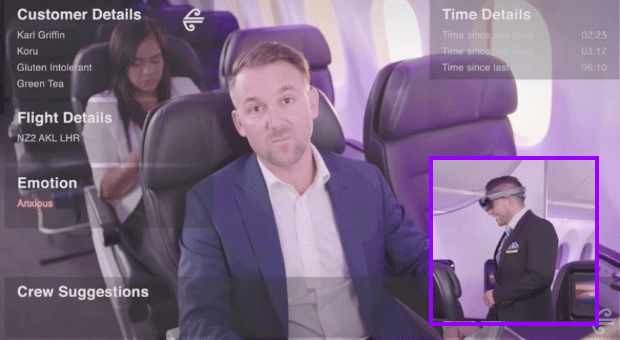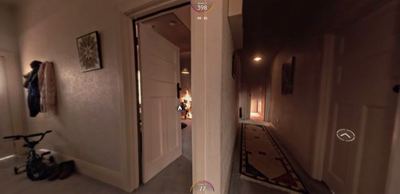|
** Last updated 29 May 2017 - Now '13 of the Best' **
(5 min read) Since 'best' is a subjective term, let's first quickly clarify that the list below is a selection of digital campaigns that we personally found to be innovative and interesting over the past 12 months or so. Most importantly, we've focused on campaigns and products demonstrating a creative, marketing application of modern digital technology in a unique and/or specific way. Were all of these campaign examples successful? We're not entirely sure. Are there others that deserve a spot on this list? Most definitely. We'll try to keep the list up to date as we move through the remainder of 2017. Let's dive in, in no particular order. 13. Air New Zealand AR to Read Customer Emotions
May 2017
Augmented reality (AR) could one day be used by flight attendants to immediately get information about your favourite drink, destination, loyalty status, meal preferences and even figure out how you are feeling. A collaboration between Air New Zealand and Dimension Data, the project is currently in beta but there's room for further AR experiments. Read the full story here. 12. Coca-Cola Targeted Ads Based on People’s Facebook & Instagram Photos
May 2017
Coca-Cola wanted to nudge users to consider its 'Gold Peak' brand of iced tea. To do so, they trawled through people's photos on Facebook, Instagram and Twitter and served them hyper-targeted ads based on images they shared on those social media platforms. To make this a reality, they tapped into an image recognition engine to identify people who posted images that:
Talk about specific targeting! Read more here. 11. Blippar: Augmented Reality in Banner Ads
8 May 2017
What's the next logical step from Pokemon Go? How about augmented reality in digital ad placements. Enter Blippar. From their Youtube page: "Introducing the world’s first augmented reality digital ad unit - augmented reality digital placement (ARDP). The new technology enables rich media units to leverage a user’s smartphone or desktop camera to bring brand experiences to life in AR without the need for a separate app or a special device." Watch the full video here. 10. New Zealand Fire Service 'Escape My House'
22 Mar 2017
'Escape My House' is an interactive experience that takes place inside a real house fire, demonstrating in a very tangible and immersive way the need for households to be prepared for a fire and why they need an escape plan. FCB New Zealand has used a combination of interactive 360 video (with a virtual reality (VR) option) in a technology first in partnership with the New Zealand Fire Service. The experience is of an actual house fire, which the user is challenged to escape. What looks like a manageable fire is, in fact, already out of control and you have only seconds to get out safely. 9. King Kong Movie Google Maps 'Skull Island'
Feb-Mar 2017 (approx.)
A fictional location as part of the upcoming King Kong movie release, for a limited period of time 'Skull Island' was added to Google Maps by Google in partnership with Legendary and Universal Pictures. It appears as an 'archaeological site' off the west of the coast of Peru and near the equator. Users can post their own photos and 'fantasy reviews' of Skull Island. 8. Audi Q2 #Untaggable Hashtag Generator
Mar 2017 (approx.)
Audi's statement for the campaign is: 'We have a hashtag for everything. What should be the hashtag for Audi Q2? That's #untaggable'. Users are encouraged to create a hashtag for the new Q2 crossover SUV. The campaign is tied in with an interesting 'hashtag generator' on Audi's site, which on the mobile version let's you shake your phone to generate random hashtags. Watch the full Audi video ad here. 7. Ikea Renamed Products After Frequently Googled Problems That Those Products Solve
Dec 2016 (approx.)
In a clever play on user intent and how this is used by search engines like Google as part of it's algorithm to display search results, Ikea not only came up with an interesting campaign, but also one with a very solid grounding in SEO principles. Apparently 'unrequited love' can be solved for just $14.99. 6. 'Alice Through the Looking Glass' Wonder Mirror
Early 2016
In a high budget use of complex facial recognition and 'real time augmented facial transformation', Part IV delivered a creative, interactive experience for Disney that 'hadn't really been accomplished before'. Users could transform their faces in real time to look like characters from the movie. Instagram-sized videos and a photo were then emailed to users as soon as they completed the experience. Check out the full case study here. 5. The Banner Ad that 'Can See What You See'
Early-Mid 2016
In this example, one of Europe's largest energy companies Vattenfall combined real time user data from Sweden's largest real estate website with sophisticated real-time image recognition to show custom, dynamic creative and call to actions to around 2 million users per week, personalised based on the image that they are viewing at the time. The end result: a dynamic banner ad that can adapt it's messaging to millions of images, all in real time. Read the full case study here. 4. UNICEF's Hidden Banner With a Strong Message
Early 2016
According to the case study, 25% of online users in Sweden use ad blockers to prevent banner images (ads) from showing on websites. In this example, UNICEF had an important message for the campaign to deliver and they needed as many people as possible to sign an online petition for children's rights. The solution: to turn this technology around and target a message specifically to these 25% of users. A 'disguised banner' was created that would get past the ad blocker software and delivered a simple message that earned it’s space: “Children’s rights should never be blocked. Sign up for children’s rights to complain.” Read the full case study here 3. Virgin's Push for VR
Early 2016
It's great to see many creative examples of VR emerging and being used in digital marketing campaigns. It's a bit sad then, that at the same time, many sources are reporting a slower-than-expected adoption of the new technology in 2017 - a year that was touted by many as 'the year of VR'. The biggest hurdle seems to be a stalemate between content producers that are waiting for more advertisers to come on board and advertisers who seem hesitant due to a lack of content producers. Hopefully we see this hurdle overcome soon. Virgin has been one of the first to embrace VR with considerable gusto. Virgin created a unique solution where customers in stores could be entertained while they waited with a virtual tour of Virgin Holidays’ destinations, allowing them to ‘try before they buy’. The content was filmed from a first person perspective, 'so everything captured, at every angle, was the sensation and visuals a customer could experience themselves.'
*The last two mentions are more 'products' than 'campaigns'. However, they certainly satisfy the criteria of being innovative and were just too awesome/weird not to include in this list.
2. Pizza Hut 'Pie Tops' - Order Pizza From Your Shoe
March 2017
Yes, really. Whilst they may not be the future of shoes, the interestingly named 'Pie Tops' are part of a Pizza Hut ad campaign starring retired basketball player Grant Hill. The shoes feature built-in bluetooth that syncs to a mobile app. 'When a user squeezes the right tongue once or twice (this can be adjusted in the settings to avoid accidental activation), it places an order for whatever style of pizza the wearer has saved in the app.' Read the full article here. 1. Google and Levi's 'Project Jacquard'
Early-Mid 2017
It might look (or sound) like a gimmick at first, but Google and Levi's seem quite serious about their next swing at the wearables market. Slated to release in the US in Spring for around $350, the technology is much more than just adding wi-fi connectivity to a jacket. According to the official site, the technology actually 'makes it possible to weave touch and gesture interactivity into any textile using standard, industrial looms.' This means that 'Everyday objects such as clothes and furniture can potentially be transformed into interactive surfaces.' Excited yet? The jacket is even planned to come with it's own API for app developers. Get the full story here
Check back for updates to this article. Feel free to share other examples in the comments section.
0 Comments
Your comment will be posted after it is approved.
Leave a Reply. |














 RSS Feed
RSS Feed
